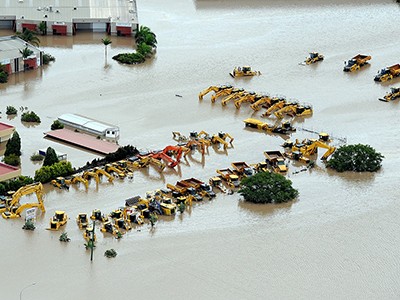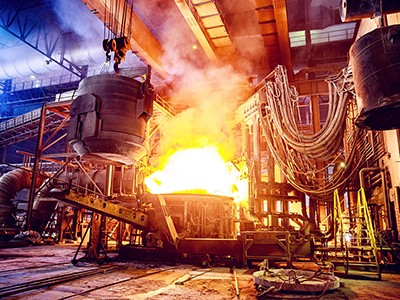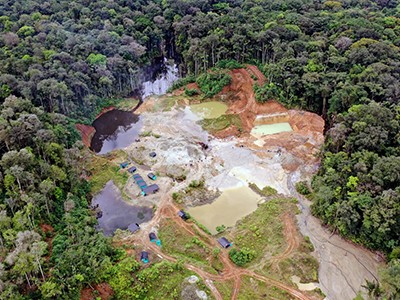It was a gathering that shocked the world. On 28 February, Ukrainian President Volodymyr Zelenskyy met with US President Donald Trump within the Oval Workplace. Trump’s purpose was “getting a number of the uncommon earth” as fee for US weapons after Russia’s invasion of Ukraine in 2022. Negotiations broke down on the assembly, however later, on 30 April, Trump landed his deal. And he has been looking for different offers since, together with signing a joint settlement with Australia on 21 October to safe critical-mineral and rare-earth provide chains.
Local weather change is devastating mining of minerals wanted to combat it
Entry to minerals has lengthy been an undercurrent of worldwide relations, however hardly ever has it been so overtly espoused, or so at odds with what the general public thought these minerals had been for. As soon as promoted because the minerals of the vitality transition and digital transformations, Trump overtly justifies important minerals because the minerals of warfare. “We’re going to be… taking it, utilizing it for all of the issues we do,” Trump mentioned in February, “together with … weapons and the navy” (see go.nature.com/47by3cn).
Though minerals are on the centre of latest discussions on warfare, renewable vitality and expertise, they’re additionally of immense relevance to human growth, notably ending poverty in all its varieties — the primary precedence of the UN Sustainable Improvement Targets (SDGs).
Right here we hint the national-security origins of the time period important minerals and what this means for international inequality. We then draw classes from how different pure sources have been reframed to indicate why a human-centred method is important to satisfy humanity’s wants for these minerals.
Geopolitical origins
Important minerals have lengthy been a spotlight of navy planning. As early because the First World Warfare, the Warfare Industries Board compiled an inventory of strategic and important minerals that had been essential to US business and in brief provide1. In 1921, the US Military Basic Employees adopted its first official record distinguishing between minerals that had been ‘strategic’ for defence and business; people who had been ‘important’ owing to shortages; and people who had been ‘important’ even when they didn’t meet both standards. In 1944, the US Military and Navy Munitions Board developed a mixed definition of ‘strategic and important minerals’ as “these supplies required for important makes use of in a warfare emergency…the procurement of which [is] sufficiently unsure for any motive to require prior provision for the availability thereof”1.
Frequent adjustments to the lists, terminology and coverage adopted in the USA, however it was the 2010 ‘rare-earth disaster’ that triggered the up to date curiosity by a wider array of nations.
Metals are key to the worldwide economic system — however three challenges threaten provide chains
On 7 September 2010, a Chinese language fishing boat collided with two Japanese Coast Guard vessels off the Senkaku islands within the East China Sea. The arrest of the fishing-boat captain triggered a diplomatic incident between the 2 nations. At across the similar time, China halted exports of rare-earth parts (REEs), of which Japan was a significant importer. This triggered costs to skyrocket, revealing the financial vulnerability of nations when mineral provide chains are slim.
Japan’s response, which was to spend money on diversification, stockpiling, recycling and alternate options, grew to become a blueprint for wider efforts. It spurred the event of critical-minerals methods and lists by the European Union (2011), the USA (2018), Australia (2019), Canada (2021), the UK (2022), India, Indonesia, Japan and South Korea (2023), and South Africa and New Zealand (2025).
In 2022, many of those nations got here collectively below the Minerals Safety Partnership to coordinate efforts to enhance provide safety. These methods and lists construct on the US definition, refined over the previous century: a important mineral is a fabric that’s important to the economic system or nationwide safety, has a provide chain weak to disruption and is essential for manufacturing a product.
Important-mineral confusion
After the rare-earth disaster, and the 2015 Paris settlement, addressing local weather change grew to become a extra pressing coverage precedence for numerous governments and worldwide establishments, lots of which started utilizing the time period important minerals as if it meant the minerals of renewable vitality. In fact, nevertheless, most important minerals usually are not energy-transition minerals, and most energy-transition minerals usually are not important minerals.
For example, roughly 60% of the important minerals on the EU, US and Australian lists don’t have any energy-transition use case2. Certainly, the EU consists of coking coal on its record. Conversely, important minerals make up lower than 2% of energy-transition mineral demand (by quantity). Mineral substances of concrete, resembling sand and cement, that are essential for renewable vitality infrastructure, represent 70% of demand2.
Superpowers need to management important mineral provides — native communities want a stronger say
Even when quantity is put aside, many minerals wanted for the vitality transition don’t characteristic on important mineral lists2. Copper, for instance, is important to renewable vitality however isn’t sometimes thought-about important, given its various provide and restricted vulnerability to disruption. There are exceptions, nevertheless, together with South Korea, which incorporates it on its record.
In different phrases, important minerals are outlined not as minerals which can be essential, however as these which can be in a state that’s weak to disruption — important as in ‘the important care unit of a hospital’, not important as in ‘society can’t reside with out them’.
And though provide disruption is related, any try to plan for the vitality transition ought to be involved with all of the minerals which can be mandatory, not simply these with slim provide chains. The mineral substances of concrete are essential, but they’re absent from the dialogue, or certainly any planning, regardless that they face enormous affordability, sustainability and environmental points3.
Important to whom?
The belief that the time period important mineral isn’t a synonym for energy-transition mineral has led some establishments to hunt alternate options.
The United Nations Setting Programme and the Extractive Industries Transparency Initiative each use the time period ‘transition mineral’. Chemists will instantly choose up the awkwardness of utilizing this time period as a result of ‘transition metals’ are already often known as a gaggle of twelve parts within the d-block of the periodic desk.

Quarry staff reduce slabs of limestone in Egypt.Credit score: Ahmed Gamal/NurPhoto through Getty
Equally, the UN Secretary-Basic’s Panel on Important Vitality Transition Minerals used the time period ‘important vitality transition minerals’ in its 2024 report4. Its remit was confined to these minerals mandatory for setting up, producing, distributing and storing renewable vitality and related infrastructure.
The African Union, too, averted the time period important minerals in its Inexperienced Minerals Technique, partly due to a need to focus solely on energy-transition minerals, but additionally as a result of the time period begs the query, important to whom?
Throughout African nations, it’s common to listen to the phrase, ‘important minerals usually are not important to us’. They usually have a degree. Most nations which have critical-mineral lists are industrialized and trying to shore up mineral imports. There are exceptions, together with Australia, Canada and South Africa, who’re mineral exporters. Their lists embody minerals deemed important not for themselves, however for import by their buying and selling companions.
The highest exporters of uncooked important minerals even have one thing in frequent: they lack a big industrial base. Within the context of a primarily one-way movement of minerals from low- and middle-income nations (LMICs) to high-income nations, it’s comprehensible that exporters may assume that the worldwide critical-minerals agenda isn’t targeted on their very own wants. Though they may — or may not — be capable to safe part of the processing worth chain or income and employment from mineral extraction, in the end the minerals are used elsewhere.
The human flip
A mineral-security agenda that’s outlined solely by the national-security priorities of industrialized nations is liable to geopolitical competition and neglect of the broader wants of humanity.
The world has been right here earlier than — the idea of vitality safety was popularized as a national-security response to the Seventies oil disaster. Equally, the idea of meals safety prioritized nationwide availability. Solely after the Nobel-prizewinning work of economist Amartya Sen within the early Eighties and Nineteen Nineties recognized that it’s not broader disruptions to produce that trigger famine, however the inaccessibility of meals for these people who want it5, had been these ideas reframed from a human-centred perspective.
Impacts for half of the world’s mining areas are undocumented
Sen would go on to assist publish the primary UN Human Improvement report with Pakistani economist Mahbub ul Haq in 1990, they usually and others would outline the phrase human safety, within the 1994 model of the report6. Human safety is ‘freedom from concern’ and ‘freedom from need’. It places individuals on the centre of research — it imagines that the safety of all individuals is rather more than their bodily security, and it’s meant to enhance, not change nationwide safety.
The human-centred variations of meals safety, vitality safety and water safety, which emphasize accessibility to all individuals, are actually central concepts within the SDGs. But, that’s not the case for minerals.
It’s onerous to imagine it, however the 15,000-word SDG agenda Remodeling Our World makes no reference to minerals — the one pure useful resource that’s lacking. Not solely do minerals lack a related purpose, however the useful resource, occupations, sector and actions don’t seem within the agenda7. The omission of minerals from the SDGs has led abroad growth help to the mineral sector to plummet to only below US$600 million of the $239 billion spent by 2021, representing 0.2%, among the many lowest by sector.



